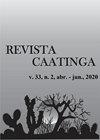Water regimes on the development of accessions of the Manihot genus
IF 0.9
4区 农林科学
Q3 AGRONOMY
引用次数: 0
Abstract
ABSTRACT The objective of this work was to select water deficittolerant accessions of the genus Manihot, through morphological characters under different water regimes. The experiment was conducted in a randomized block design, using a split-plot arrangement with plots consisting of tree water regimes (simulated rainfall and water depth of 100 and 20% crop evapotranspiration (ETc)), and subplots consisting of eight accessions of the genus Manihot (Gema-de-Ovo and Engana-Ladrão from the species M. esculenta Crantz, and BGMS-115, BGMS-110, BGMS-102, BGMS- 79, BGMS-24, and BGMS-48 from Manihot sp.). The accessions were evaluated considering two crop cycles: the first had 120 and 60 days from the application of the treatments. Plant height, stem diameter, number of leaves, leaf lobe length and shoot dry mass production were evaluated. For each cropping cycle, a split-plot analysis of variance was performed. The highest genotypic means were expressed by the accessions BGMS-115, BGMS-102, BGMS- 79 and BGMS-24 for most of the analyzed variables, regardless of the cultivation cycle. For the characteristic shoot dry mass production, accessions BGMS-102 and BGMS-79 showed the best performances under conditions of limited water regime (20% ETc), regardless of the cropping cycle. Accession BGMS-102 was also grouped in the group with the highest genotypic means, for this trait, in treatments with rain simulation and 100% ETc, in the first cycle, demonstrating that, under stress conditions, this accession is an option to tolerate low water precipitation and responds well when higher precipitation occurs.马尼奥特属植物生长发育的水分状况
摘要本研究的目的是通过不同水分条件下马尼奥特属植物的形态特征来筛选耐缺水材料。试验采用随机区组设计,采用分块布置,样地包括树木水分状况(模拟降雨量和作物蒸散量的100%和20%),子样地包括8个马尼奥特属植物(M. esculenta Crantz的Gema-de-Ovo和engana - ladr o,以及马尼奥特属植物BGMS-115、BGMS-110、BGMS-102、BGMS- 79、BGMS-24和BGMS-48)。根据两个作物周期对材料进行评价:第一个作物周期为施用后120天和60天。对株高、茎粗、叶数、叶长和地上部干产量进行了评价。对于每个种植周期,进行了分块方差分析。无论栽培周期如何,BGMS-115、BGMS-102、BGMS- 79和BGMS-24在大多数分析变量上的基因型均值均最高。在不同的种植周期条件下,BGMS-102和BGMS-79在水分限制条件下(20%等)表现最佳。在第一个循环中,BGMS-102也被归为该性状在模拟降雨和100% ETc处理中基因型平均值最高的组,这表明,在胁迫条件下,该组合是耐受低降水的选择,并且在高降水发生时反应良好。
本文章由计算机程序翻译,如有差异,请以英文原文为准。
求助全文
约1分钟内获得全文
求助全文
来源期刊

Revista Caatinga
AGRONOMY-
CiteScore
2.10
自引率
11.10%
发文量
67
审稿时长
6-12 weeks
期刊介绍:
A Revista Caatinga é uma publicação científica que apresenta periodicidade trimestral, publicada pela Pró-Reitoria de Pesquisa e Pós-Graduação da Universidade Federal Rural do Semi-Árido – UFERSA, desde 1976.
Objetiva proporcionar à comunidade científica, publicações de alto nível nas áreas de Ciências Agrárias e Recursos Naturais, disponibilizando, integral e gratuitamente, resultados relevantes das pesquisas publicadas.
 求助内容:
求助内容: 应助结果提醒方式:
应助结果提醒方式:


